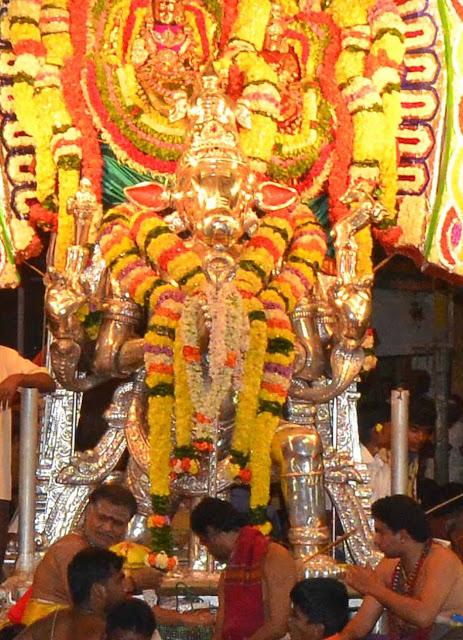In the evening of November 14, 2015 Pidari Ursavam was observed at the Pidari Shrine, which is located in the 3rd Prakaram of Arunachaleswarar Temple.
 |
| The Goddess |
In front of the Pidari shrine, which faces North, there is a stone trident and two Bali peethas or sacrificial altars. Inside the Pidari shrine are representations of; Ganesha, Sapta Kanyas or seven ‘Matris’ (chiselled in separate stones), a severed head of a Goddess with a crown and Nidambasudani who gives darshan with eight arms. This severed head represents ‘Renuka’ the Goddess worshipped at Padaiveedu, a town about 30 miles from Tiruvannamalai. Renuka represents the ‘Formidable’ the ‘Fearful’ aspect of Kali, the consort of Siva. The stoned head of ‘Reunka’ is about 2½ high and although it has a slightly damaged nose, is a very beautiful image.
 |
| Pidari Shrine, 3rd Prakaram, Big Temple |
Goddess Pidari is Kali in a rural setting and regarded as being a consort of Siva. Pidari is the ferocious aspect of Amman. The Mother Goddess gives life but Kali takes life. Goddess Pidari is the feminine form of Kala—time. Kali is the energy or the power of time. Her blackness swallows all that exists and the emptiness of space is her clothing, for when the Universe is dissolved, the power of time remains without maya (veil).
Kali’s extension, Pidari and her worship; evolved as a fighter and warrior and gained importance with the influence of Tantrism where she is known as Kala Pidari. The Pidari Goddess, in line with Shakti manifestations, emphasises fierce symbolism. At times Pidari is the sole resident deity in a village. As devata, She is the all-in-all for the village from simple prayers to Divine blessings.
 |
| Goddess circumambulating the Temple perimeter streets |
This Goddess also watches over the main deity of a Temple in Her role as ‘kaval deivam’ while taking Her seat in a structure on the right hand side of a Temple’s entrance. She joins the ‘kavaldeivam’ or Protection Gods’ similar to that of Ayyanar, Muniandy, Karuppana Swamy or Veerabadhra, all of whom are warrior-protection village gods.
 |
| Goddess procession |

























































